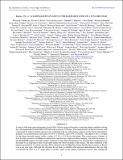Kepler-22b: A 2.4 EARTH-RADIUS PLANET IN THE HABITABLE ZONE OF A SUN-LIKE STAR
Author(s)
Demory, Brice-Olivier; Carter, Joshua Adam
DownloadBorucki-2012-Kepler-22b_ A 2.4 EA.pdf (2.152Mb)
PUBLISHER_POLICY
Publisher Policy
Article is made available in accordance with the publisher's policy and may be subject to US copyright law. Please refer to the publisher's site for terms of use.
Terms of use
Metadata
Show full item recordAbstract
A search of the time-series photometry from NASA's Kepler spacecraft reveals a transiting planet candidate orbiting the 11th magnitude G5 dwarf KIC 10593626 with a period of 290 days. The characteristics of the host star are well constrained by high-resolution spectroscopy combined with an asteroseismic analysis of the Kepler photometry, leading to an estimated mass and radius of 0.970 ± 0.060 M [subscript ☉] and 0.979 ± 0.020 R [subscript ☉]. The depth of 492 ± 10 ppm for the three observed transits yields a radius of 2.38 ± 0.13 Re for the planet. The system passes a battery of tests for false positives, including reconnaissance spectroscopy, high-resolution imaging, and centroid motion. A full BLENDER analysis provides further validation of the planet interpretation by showing that contamination of the target by an eclipsing system would rarely mimic the observed shape of the transits. The final validation of the planet is provided by 16 radial velocities (RVs) obtained with the High Resolution Echelle Spectrometer on Keck I over a one-year span. Although the velocities do not lead to a reliable orbit and mass determination, they are able to constrain the mass to a 3σ upper limit of 124 M [subscript ⊕], safely in the regime of planetary masses, thus earning the designation Kepler-22b. The radiative equilibrium temperature is 262 K for a planet in Kepler-22b's orbit. Although there is no evidence that Kepler-22b is a rocky planet, it is the first confirmed planet with a measured radius to orbit in the habitable zone of any star other than the Sun.
Date issued
2012-01Department
Massachusetts Institute of Technology. Department of Earth, Atmospheric, and Planetary Sciences; MIT Kavli Institute for Astrophysics and Space ResearchJournal
Astrophysical Journal
Publisher
IOP Publishing
Citation
Borucki, William J., David G. Koch, Natalie Batalha, Stephen T. Bryson, Jason Rowe, Francois Fressin, Guillermo Torres, et al. “Kepler-22b: A 2.4 EARTH-RADIUS PLANET IN THE HABITABLE ZONE OF A SUN-LIKE STAR.” The Astrophysical Journal 745, no. 2 (January 6, 2012): 120. © 2012 The American Astronomical Society
Version: Final published version
ISSN
0004-637X
1538-4357